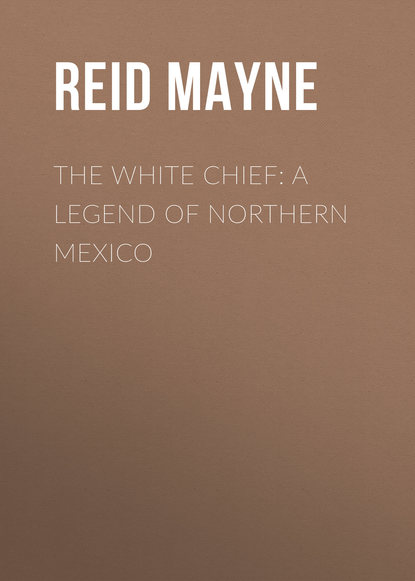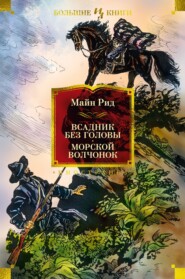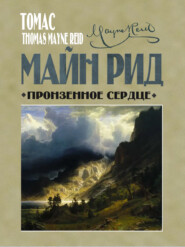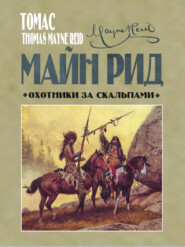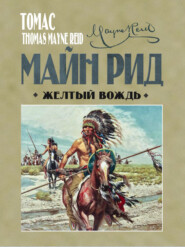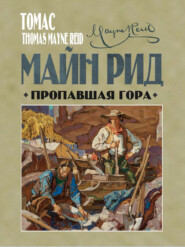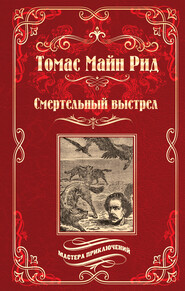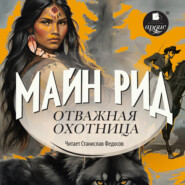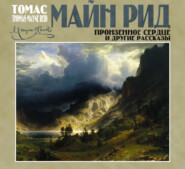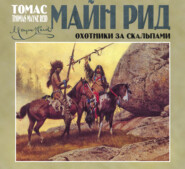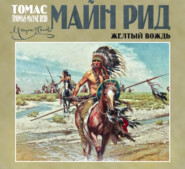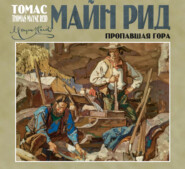По всем вопросам обращайтесь на: info@litportal.ru
(©) 2003-2025.
✖
The White Chief: A Legend of Northern Mexico
Настройки чтения
Размер шрифта
Высота строк
Поля
The White Chief: A Legend of Northern Mexico
Mayne Reid
Mayne Reid
The White Chief: A Legend of Northern Mexico
Chapter One
Deep in the interior of the American Continent – more than a thousand miles from the shores of any sea – lies our scene.
Climb with me yonder mountain, and let us look from its summit of snow.
We have reached its highest ridge. What do we behold?
On the north a chaos of mountains, that continues on through thirty parallels to the shores of the Arctic Sea! On the south, the same mountains, – here running in separate sierras, and there knotting with each other. On the west, mountains again, profiled along the sky, and alternating with broad tables that stretch between their bases.
Now turn we around, and look eastward. Not a mountain to be seen! Far as the eye can reach, and a thousand miles farther, not a mountain. Yonder dark line rising above the plain is but the rocky brow of another plain – a steppe of higher elevation.
Where are we? On what summit are we standing? On the Sierra Blanca, known to the hunter as the “Spanish Peaks.” We are upon the western rim of the Grand Prairie.
Looking eastward, the eye discovers no signs of civilisation. There are none within a month’s journeying. North and south, – mountains, mountains.
Westward, it is different. Through the telescope we can see cultivated fields afar off, – a mere strip along the banks of a shining river. Those are the settlements of Nuevo Mexico, an oasis irrigated by the Rio del Norte. The scene of our story lies not there.
Face once more to the eastward, and you have it before you. The mountain upon which we stand has its base upon a level plain that expands far to the east. There are no foot-hills. The plain and the mountain touch, and at a single step you pass from the naked turf of the one to the rocky and pine-clad declivities of the other.
The aspect of the plain is varied. In some places it is green, where the gramma-grass has formed a sward; but in most parts it is sterile as the Sahara. Here it appears brown, where the sun-parched earth is bare; there it is of a sandy, yellowish hue; and yonder the salt effervescence renders it as white as the snow upon which we stand.
The scant vegetation clothes it not in a livery of verdure. The leaves of the agave are mottled with scarlet, and the dull green of the cactus is still further obscured by its thickly-set spines. The blades of the yuccas are dimmed by dust, and resemble clusters of half-rusty bayonets; and the low scrubby copses of acacia scarce offer a shade to the dusky agama and the ground rattlesnake. Here and there a solitary palmetto, with branchless stem and tufted crown, gives an African aspect to the scene. The eye soon tires of a landscape where every object appears angular and thorny; and upon this plain, not only are the trees of that character, but the plants, – even the very grass carries its thorns!
With what sensations of pleasure we turn to gaze into a lovely valley, trending eastward from the base of the mountain! What a contrast to the arid plain! Its surface is covered with a carpet of bright green, enamelled by flowers that gleam like many-coloured gems; while the cotton-wood, the wild-china-tree, the live-oak, and the willow, mingle their foliage in soft shady groves that seem to invite us. Let us descend!
We have reached the plain, yet the valley is still far beneath us – a thousand feet at the least – but, from a promontory of the bluff projecting over it, we command a view of its entire surface to the distance of many miles. It is a level like the plain above; and gazing down upon it, one might fancy it a portion of the latter that had sunk into the earth’s crust, so as to come within the influence of a fertilising power denied to the higher region.
On both sides of it, far as the eye can reach, run the bordering cliffs, stepping from one level to the other, by a thousand feet sheer, and only passable at certain points. There is a width of ten miles from cliff to cliff; and these, of equal height, seem the counterparts of each other. Their grim savage fronts, overhanging the soft bright landscape of the valley, suggest the idea of a beautiful picture framed in rough oak-work.
A stream, like a silver serpent, bisects the valley – not running in a straight course, but in luxuriant windings, as though it loved to tarry in the midst of that bright scene. Its frequent curves and gentle current show that it passes over a surface almost plane. Its banks are timbered, but not continuously. Here the timber forms a wide belt, there only a fringe scarce shadowing the stream, and yonder the grassy turf can be distinguished running in to the very water’s edge.
Copse-like groves are scattered over the ground. These are of varied forms; some perfectly circular, others oblong or oval, and others curving like the cornucopias of our gardens. Detached trees meet the eye, whose full round tops show that Nature has had her will in their development. The whole scene suggests the idea of some noble park, planted by design, with just timber enough to adorn the picture without concealing its beauties.
Is there no palace, no lordly mansion, to correspond? No. Nor palace nor cottage sends up its smoke. No human form appears within this wild paradise. Herds of deer roam over its surface, the stately elk reposes within the shade of its leafy groves, but no human being is there. Perhaps the foot of man never —
Stay! there is one by our side who tells a different tale. Hear him.
“That is the valley of San Ildefonso.” Wild though it appears, it was once the abode of civilised man. Near its centre you may note some irregular masses scattered over the ground. But for the trees and rank weeds that cover them, you might there behold the ruins of a city.
“Yes! on that spot once stood a town, large and prosperous. There was a Presidio with the flag of Spain flying from its battlements; there was a grand Mission-house of the Jesuit padrés; and dwellings of rich miners and ‘hacendados’ studded the valley far above and below. A busy populace moved upon the scene; and all the passions of love and hate, ambition, avarice, and revenge, have had existence there. The hearts stirred by them are long since cold, and the actions to which they gave birth are not chronicled by human pen. They live only in legends that sound more like romance than real history.
“And yet these legends are less than a century old! One century ago, from the summit of yonder mountain could have been seen, not only the settlement of San Ildefonso, but a score of others – cities, and towns, and villages – where to-day the eye cannot trace a vestige of civilisation. Even the names of these cities are forgotten, and their histories buried among their ruins!
“The Indian has wreaked his revenge upon the murderers of Moctezuma! Had the Saxon permitted him to continue his war of retaliation, in one century more – nay, in half that time – the descendants of Cortez and his conquerors would have disappeared from the land of Anahuac!
“Listen to the ‘Legend of San Ildefonso’!”
Chapter Two
Perhaps in no country has religion so many devoted days as in Mexico. The “fiestas” are supposed to have a good effect in Christianising the natives, and the saints’ calendar has been considerably enlarged in that pseudo-holy land. Nearly every week supplies a festival, with all its mummery of banners, and processions, and priests dressed as if for the altar-scene in “Pizarro,” and squibs, and fireworks, and silly citizens kneeling in the dust, and hats off all round. Very much like a London Guy-Fawkes procession is the whole affair, and of about like influence upon the morals of the community.
Of course the padrés do not get up these ceremonial exhibitions for mere amusement – not they. There are various little “blessings,” and “indultos,” and sprinklings of sacred water, to be distributed on these occasions – not gratuitously– and the wretched believer is preciously “plucked” while he is in the penitent mood – at the same time he is promised a short and easy route to heaven.
As to any solemnity in the character of the ceremonials, there is nothing of the sort. They are in reality days of amusement; and it is not uncommon to see the kneeling devotee struggling to keep down the cackle of his fighting-cock, which, full-galved, he carries under the folds of his serapé! All this under the roof of the sacred temple of God!
On days of fiesta, the church genuflexions are soon over; and then the gambling-booth, the race-course, bull-baiting, the cock-pit, and various minor amusements, come into full operation. In all these you may meet the robed priest of the morning, and stake your dollar or doubloon against his, if you feel so inclined.
“San Juan” is one of the “fiestas principales” – one of the most noted of Mexican ceremonials. On this day – particularly in a New Mexican village – the houses are completely deserted. All people turn out, and proceed to some well-known locality, usually a neighbouring plain, to witness the sports – which consist of horse-racing, “tailing the bull,” “running the cock,” and the like. The intervals are filled up by gambling, smoking, and flirtation.
There is much of republican equality exhibited on these occasions. Rich and poor, high and low, mingle in the throng, and take part in the amusements of the day.
It is the day of San Juan. A broad grassy plain lies just outside the town of San Ildefonso, and upon this the citizens are assembled. It is the scene of the festival, and the sports will soon begin. Before they do, let us stroll through the crowd, and note its component parts. All classes of the community – in fact, all the community – appear to be present. There go the two stout padrés of the mission, bustling about in their long gowns of coarse serge, with bead-string and crucifix dangling to their knees, and scalp-lock close shaven. The Apache will find no trophy on their crowns.
There is the cura of the town church, conspicuous in his long black cloak, shovel hat, black silk stockings, pumps, and buckles. Now smiling benignly upon the crowd, now darting quick Jesuitical glance from his dark ill-meaning eyes, and now playing off his white jewelled fingers, as he assists some newly-arrived “señora” to climb to her seat. Great “ladies’ men” are these same black-gowned bachelor-churchmen of Mexico.
We have arrived in front of several rows of seats raised above one another. Let us observe who occupy them. At a glance it is apparent they are in possession of the “familias principales,” the aristocracy of the settlement. Yes – there is the rich “comerciante,” Don José Rincon, his fat wife, and four fat sleepy-looking daughters. There, too, is the wife and family of the “Alcalde,” and this magistrate himself with tasselled official staff; and the Echevarrias – pretty creatures that they think themselves – under care of their brother, the beau, who has discarded the national costume for the mode de Paris! There is the rich “hacendado,” Señor Gomez del Monte, the owner of countless flocks and broad acres in the valley; and there are others of his class with their señoras and señoritas. And there, too, observed of all, is the lovely Catalina de Cruces, the daughter of Don Ambrosio, the wealthy miner. He will be a lucky fellow who wins the smiles of Catalina, or rather perhaps the good graces of her father – for Don Ambrosio will have much to say in the matter of her marriage. Indeed, it is rumoured that that matter is already arranged; and that Captain Roblado, second in command at the Presidio, is the successful suitor. There stands he, in full moustache, covered with gold-lace, back and front, and frowning fiercely on every one who dares to rest eye for a moment upon the fair Catalina. With all his gold-lace and gallant strut, Catalina displays no great taste in her choice; – but is he her choice? Maybe not – maybe he is the choice of Don Ambrosio; who, himself of plebeian origin, is ambitious that his blood should be mingled with that of the military hidalgo. The soldier has no money – beyond his pay; and that is mortgaged for months in advance; but he is a true Gachupino, of “blue blood,” a genuine “hijo de algo.” Not a singular ambition of the old miser, nor uncommon among parvenus.
Vizcarra, the Comandante, is on the ground – a tall colonel of forty – laced and plumed like a peacock. A lively bachelor is he; and while chatting with padré, cura, or alcalde, his eye wanders to the faces of the pretty poblanas that are passing the spot. These regard his splendid uniform with astonishment, which he, fancying himself “Don Juan Tenorio,” mistakes for admiration, and repays with a bland smile.
There, too, is the third officer – there are but the three – the teniente, Garcia by name. He is better looking, and consequently more of a favourite with both poblanas and rich señoritas, than either of his superiors. I wonder the fair Catalina does not give her preference to him. Who can tell that she does not? A Mexican dame does not carry her soul upon her sleeve, nor upon her tongue neither.
It would be a task to tell of whom Catalina is thinking just now. It is not likely at her age – she is twenty – that her heart is still her own; but whose? Roblado’s? I would wager, no. Garcia’s? That would be a fairer bet. After all, there are many others – young “hacendados,” employés of the mines, and a few merchant dandies of the town. Her choice may be some one of these. Quien sabe?
Let us on through the crowd!
We see the soldiers of the garrison, with tinkling spurs and long trailing sabres, mingling fraternally with the serapé-clad tradesmen, the gambucinos, and rancheros of the valley. They imitate their officers in strut and swagger – the very character of which enables one to tell that the military power is here in the ascendant. They are all dragoons – infantry would not avail against an Indian enemy – and they fancy that the loud clinking of their spurs, and the rattle of their steel scabbards, add greatly to their importance. They have their eyes after the poblanas, and the sweethearts of the poblanas keep their eyes after them in a constant vigil of jealousy.
The “poblanas” are the pretty girls of the place; but, pretty or plain, all the girls are out to-day in their best and gayest apparel. Some wear enaguas of blue – others of scarlet – others of purple; and many of them tastefully flounced at the bottoms with a trimming of narrow lace. They wear the embroidered chemisette, with its snow-white frills, and the blueish reboso, gracefully arranged, so as to conceal neck, bosom, arms, and, in some cases of coquetry, even the face! Ere night this jealous garment will have lost half its prudery. Already the prettier faces peep forth; and you may see, from the softness of the complexion, that they have been just washed free of the “allegria” that for the last two weeks has rendered them hideous.
The “rancheros” are in their full and beautiful costume – velveteen trousers, wide at the bottoms and open up the sides; botas of unstained leather; jackets of tanned sheepskin; or velveteen richly embroidered; fancy-worked shirts underneath; and scarfs of rich red silk around the waist. Over all the broad-brimmed sombrero, of black glaze, with silver or gold band, and tags of the same, screwed into the crown. Some have no jacket, but the serapé, hanging negligently from their shoulders, serves in place of one. All of these men have horses with them; and on their feet may be seen spurs full five pounds in weight, with rowels three, four, and even five inches in diameter!
The “gambucinos,” and young men of the town, the smaller tradespeople, are very similarly attired; but those of higher class – the officials and “comerciantes” – are clad in broad-cloth jackets and pantaloons, not exactly of European cut, but approaching it – a sort of compromise between Paris fashions and the native costume of the country.
Another costume may be noticed, worn by many of the crowd. This is the dress of the native “Pueblos”, or Indios mansos– the poor labourers of the mines, and the neophytes of the mission. It is a simple dress, and consists of an upper garment, the tilma, a sort of coat without sleeves. A coffee-sack with a hole ripped in the bottom for the head to pass through, and a slit cut in each side for the arms, would make the “tilma.” It has no waist, and hangs nearly to the hips without other fastening than the support at the shoulders. The tilma is usually a piece of coarse rug – a cheap woollen cloth of the country, called “gerga,” of a whitish colour, with a few dyed threads to give the semblance of a pattern. This with a pair of dressed sheepskin breeches and rude sandals —guaraches– constitutes the wear of most of the “Indios mansos” of Mexico. The head is bare; and the legs, from the knee to the ankle, shine forth in all their copper-coloured nakedness.
Of these dark aborigines – the “peons” of the mission and the mines – there are hundreds stalking about, while their wives and daughters sit squatted upon the ground in rear of their petatés; upon which are piled the fruits of the soil – the tuñas, petahayas, plums, apricots, grapes, sandias, and other species of melons, with roasted nuts of the piñon-tree, the produce of the neighbouring mountains. Others keep stands of dulces and agua-miel or limonada; while others sell small loaves —piloncilios– of corn-stalk sugar, or baked roots of the agave. Some squat before fires, and prepare tortillas and chilé Colorado; or melt the sugared chocolate cake in their urn-like earthen ollas. From these humble “hucksters,” a hot peppery stew, a dish of atole, or a bowl of piñole, is to be had for a few clacos. There are other stands where you can buy cigarillos of punche, or a drink of the fiery aguardiente from Taos or El Paso; and these stands are favourite resorts of the thirsty miners and soldiers. There are no “booths,” but most of the hucksters protect themselves from the sun by a huge screen of palmetto mat (petaté) placed umbrella-like over their heads.
There is one class of persons yet to be spoken of – an important class at the festival of San Juan – they who are to be competitors in the sports – the real wrestlers in the games.
These are young men of all grades in society, and all of them mounted – of course, each in the best way he can. There they go, prancing over the ground, causing their gaily caparisoned steeds to caper and curvet, especially in front of the tiers of seated señoritas. There are miners among them, and young hacendados, and rancheros, and vaqueros, and ciboleros, and young merchants who ride well. Every one rides well in Mexico – even the dwellers in cities are good horsemen.
Nearly a hundred are there of these youths who intend to take part in the various trials of skill in equitation.
Mayne Reid
Mayne Reid
The White Chief: A Legend of Northern Mexico
Chapter One
Deep in the interior of the American Continent – more than a thousand miles from the shores of any sea – lies our scene.
Climb with me yonder mountain, and let us look from its summit of snow.
We have reached its highest ridge. What do we behold?
On the north a chaos of mountains, that continues on through thirty parallels to the shores of the Arctic Sea! On the south, the same mountains, – here running in separate sierras, and there knotting with each other. On the west, mountains again, profiled along the sky, and alternating with broad tables that stretch between their bases.
Now turn we around, and look eastward. Not a mountain to be seen! Far as the eye can reach, and a thousand miles farther, not a mountain. Yonder dark line rising above the plain is but the rocky brow of another plain – a steppe of higher elevation.
Where are we? On what summit are we standing? On the Sierra Blanca, known to the hunter as the “Spanish Peaks.” We are upon the western rim of the Grand Prairie.
Looking eastward, the eye discovers no signs of civilisation. There are none within a month’s journeying. North and south, – mountains, mountains.
Westward, it is different. Through the telescope we can see cultivated fields afar off, – a mere strip along the banks of a shining river. Those are the settlements of Nuevo Mexico, an oasis irrigated by the Rio del Norte. The scene of our story lies not there.
Face once more to the eastward, and you have it before you. The mountain upon which we stand has its base upon a level plain that expands far to the east. There are no foot-hills. The plain and the mountain touch, and at a single step you pass from the naked turf of the one to the rocky and pine-clad declivities of the other.
The aspect of the plain is varied. In some places it is green, where the gramma-grass has formed a sward; but in most parts it is sterile as the Sahara. Here it appears brown, where the sun-parched earth is bare; there it is of a sandy, yellowish hue; and yonder the salt effervescence renders it as white as the snow upon which we stand.
The scant vegetation clothes it not in a livery of verdure. The leaves of the agave are mottled with scarlet, and the dull green of the cactus is still further obscured by its thickly-set spines. The blades of the yuccas are dimmed by dust, and resemble clusters of half-rusty bayonets; and the low scrubby copses of acacia scarce offer a shade to the dusky agama and the ground rattlesnake. Here and there a solitary palmetto, with branchless stem and tufted crown, gives an African aspect to the scene. The eye soon tires of a landscape where every object appears angular and thorny; and upon this plain, not only are the trees of that character, but the plants, – even the very grass carries its thorns!
With what sensations of pleasure we turn to gaze into a lovely valley, trending eastward from the base of the mountain! What a contrast to the arid plain! Its surface is covered with a carpet of bright green, enamelled by flowers that gleam like many-coloured gems; while the cotton-wood, the wild-china-tree, the live-oak, and the willow, mingle their foliage in soft shady groves that seem to invite us. Let us descend!
We have reached the plain, yet the valley is still far beneath us – a thousand feet at the least – but, from a promontory of the bluff projecting over it, we command a view of its entire surface to the distance of many miles. It is a level like the plain above; and gazing down upon it, one might fancy it a portion of the latter that had sunk into the earth’s crust, so as to come within the influence of a fertilising power denied to the higher region.
On both sides of it, far as the eye can reach, run the bordering cliffs, stepping from one level to the other, by a thousand feet sheer, and only passable at certain points. There is a width of ten miles from cliff to cliff; and these, of equal height, seem the counterparts of each other. Their grim savage fronts, overhanging the soft bright landscape of the valley, suggest the idea of a beautiful picture framed in rough oak-work.
A stream, like a silver serpent, bisects the valley – not running in a straight course, but in luxuriant windings, as though it loved to tarry in the midst of that bright scene. Its frequent curves and gentle current show that it passes over a surface almost plane. Its banks are timbered, but not continuously. Here the timber forms a wide belt, there only a fringe scarce shadowing the stream, and yonder the grassy turf can be distinguished running in to the very water’s edge.
Copse-like groves are scattered over the ground. These are of varied forms; some perfectly circular, others oblong or oval, and others curving like the cornucopias of our gardens. Detached trees meet the eye, whose full round tops show that Nature has had her will in their development. The whole scene suggests the idea of some noble park, planted by design, with just timber enough to adorn the picture without concealing its beauties.
Is there no palace, no lordly mansion, to correspond? No. Nor palace nor cottage sends up its smoke. No human form appears within this wild paradise. Herds of deer roam over its surface, the stately elk reposes within the shade of its leafy groves, but no human being is there. Perhaps the foot of man never —
Stay! there is one by our side who tells a different tale. Hear him.
“That is the valley of San Ildefonso.” Wild though it appears, it was once the abode of civilised man. Near its centre you may note some irregular masses scattered over the ground. But for the trees and rank weeds that cover them, you might there behold the ruins of a city.
“Yes! on that spot once stood a town, large and prosperous. There was a Presidio with the flag of Spain flying from its battlements; there was a grand Mission-house of the Jesuit padrés; and dwellings of rich miners and ‘hacendados’ studded the valley far above and below. A busy populace moved upon the scene; and all the passions of love and hate, ambition, avarice, and revenge, have had existence there. The hearts stirred by them are long since cold, and the actions to which they gave birth are not chronicled by human pen. They live only in legends that sound more like romance than real history.
“And yet these legends are less than a century old! One century ago, from the summit of yonder mountain could have been seen, not only the settlement of San Ildefonso, but a score of others – cities, and towns, and villages – where to-day the eye cannot trace a vestige of civilisation. Even the names of these cities are forgotten, and their histories buried among their ruins!
“The Indian has wreaked his revenge upon the murderers of Moctezuma! Had the Saxon permitted him to continue his war of retaliation, in one century more – nay, in half that time – the descendants of Cortez and his conquerors would have disappeared from the land of Anahuac!
“Listen to the ‘Legend of San Ildefonso’!”
Chapter Two
Perhaps in no country has religion so many devoted days as in Mexico. The “fiestas” are supposed to have a good effect in Christianising the natives, and the saints’ calendar has been considerably enlarged in that pseudo-holy land. Nearly every week supplies a festival, with all its mummery of banners, and processions, and priests dressed as if for the altar-scene in “Pizarro,” and squibs, and fireworks, and silly citizens kneeling in the dust, and hats off all round. Very much like a London Guy-Fawkes procession is the whole affair, and of about like influence upon the morals of the community.
Of course the padrés do not get up these ceremonial exhibitions for mere amusement – not they. There are various little “blessings,” and “indultos,” and sprinklings of sacred water, to be distributed on these occasions – not gratuitously– and the wretched believer is preciously “plucked” while he is in the penitent mood – at the same time he is promised a short and easy route to heaven.
As to any solemnity in the character of the ceremonials, there is nothing of the sort. They are in reality days of amusement; and it is not uncommon to see the kneeling devotee struggling to keep down the cackle of his fighting-cock, which, full-galved, he carries under the folds of his serapé! All this under the roof of the sacred temple of God!
On days of fiesta, the church genuflexions are soon over; and then the gambling-booth, the race-course, bull-baiting, the cock-pit, and various minor amusements, come into full operation. In all these you may meet the robed priest of the morning, and stake your dollar or doubloon against his, if you feel so inclined.
“San Juan” is one of the “fiestas principales” – one of the most noted of Mexican ceremonials. On this day – particularly in a New Mexican village – the houses are completely deserted. All people turn out, and proceed to some well-known locality, usually a neighbouring plain, to witness the sports – which consist of horse-racing, “tailing the bull,” “running the cock,” and the like. The intervals are filled up by gambling, smoking, and flirtation.
There is much of republican equality exhibited on these occasions. Rich and poor, high and low, mingle in the throng, and take part in the amusements of the day.
It is the day of San Juan. A broad grassy plain lies just outside the town of San Ildefonso, and upon this the citizens are assembled. It is the scene of the festival, and the sports will soon begin. Before they do, let us stroll through the crowd, and note its component parts. All classes of the community – in fact, all the community – appear to be present. There go the two stout padrés of the mission, bustling about in their long gowns of coarse serge, with bead-string and crucifix dangling to their knees, and scalp-lock close shaven. The Apache will find no trophy on their crowns.
There is the cura of the town church, conspicuous in his long black cloak, shovel hat, black silk stockings, pumps, and buckles. Now smiling benignly upon the crowd, now darting quick Jesuitical glance from his dark ill-meaning eyes, and now playing off his white jewelled fingers, as he assists some newly-arrived “señora” to climb to her seat. Great “ladies’ men” are these same black-gowned bachelor-churchmen of Mexico.
We have arrived in front of several rows of seats raised above one another. Let us observe who occupy them. At a glance it is apparent they are in possession of the “familias principales,” the aristocracy of the settlement. Yes – there is the rich “comerciante,” Don José Rincon, his fat wife, and four fat sleepy-looking daughters. There, too, is the wife and family of the “Alcalde,” and this magistrate himself with tasselled official staff; and the Echevarrias – pretty creatures that they think themselves – under care of their brother, the beau, who has discarded the national costume for the mode de Paris! There is the rich “hacendado,” Señor Gomez del Monte, the owner of countless flocks and broad acres in the valley; and there are others of his class with their señoras and señoritas. And there, too, observed of all, is the lovely Catalina de Cruces, the daughter of Don Ambrosio, the wealthy miner. He will be a lucky fellow who wins the smiles of Catalina, or rather perhaps the good graces of her father – for Don Ambrosio will have much to say in the matter of her marriage. Indeed, it is rumoured that that matter is already arranged; and that Captain Roblado, second in command at the Presidio, is the successful suitor. There stands he, in full moustache, covered with gold-lace, back and front, and frowning fiercely on every one who dares to rest eye for a moment upon the fair Catalina. With all his gold-lace and gallant strut, Catalina displays no great taste in her choice; – but is he her choice? Maybe not – maybe he is the choice of Don Ambrosio; who, himself of plebeian origin, is ambitious that his blood should be mingled with that of the military hidalgo. The soldier has no money – beyond his pay; and that is mortgaged for months in advance; but he is a true Gachupino, of “blue blood,” a genuine “hijo de algo.” Not a singular ambition of the old miser, nor uncommon among parvenus.
Vizcarra, the Comandante, is on the ground – a tall colonel of forty – laced and plumed like a peacock. A lively bachelor is he; and while chatting with padré, cura, or alcalde, his eye wanders to the faces of the pretty poblanas that are passing the spot. These regard his splendid uniform with astonishment, which he, fancying himself “Don Juan Tenorio,” mistakes for admiration, and repays with a bland smile.
There, too, is the third officer – there are but the three – the teniente, Garcia by name. He is better looking, and consequently more of a favourite with both poblanas and rich señoritas, than either of his superiors. I wonder the fair Catalina does not give her preference to him. Who can tell that she does not? A Mexican dame does not carry her soul upon her sleeve, nor upon her tongue neither.
It would be a task to tell of whom Catalina is thinking just now. It is not likely at her age – she is twenty – that her heart is still her own; but whose? Roblado’s? I would wager, no. Garcia’s? That would be a fairer bet. After all, there are many others – young “hacendados,” employés of the mines, and a few merchant dandies of the town. Her choice may be some one of these. Quien sabe?
Let us on through the crowd!
We see the soldiers of the garrison, with tinkling spurs and long trailing sabres, mingling fraternally with the serapé-clad tradesmen, the gambucinos, and rancheros of the valley. They imitate their officers in strut and swagger – the very character of which enables one to tell that the military power is here in the ascendant. They are all dragoons – infantry would not avail against an Indian enemy – and they fancy that the loud clinking of their spurs, and the rattle of their steel scabbards, add greatly to their importance. They have their eyes after the poblanas, and the sweethearts of the poblanas keep their eyes after them in a constant vigil of jealousy.
The “poblanas” are the pretty girls of the place; but, pretty or plain, all the girls are out to-day in their best and gayest apparel. Some wear enaguas of blue – others of scarlet – others of purple; and many of them tastefully flounced at the bottoms with a trimming of narrow lace. They wear the embroidered chemisette, with its snow-white frills, and the blueish reboso, gracefully arranged, so as to conceal neck, bosom, arms, and, in some cases of coquetry, even the face! Ere night this jealous garment will have lost half its prudery. Already the prettier faces peep forth; and you may see, from the softness of the complexion, that they have been just washed free of the “allegria” that for the last two weeks has rendered them hideous.
The “rancheros” are in their full and beautiful costume – velveteen trousers, wide at the bottoms and open up the sides; botas of unstained leather; jackets of tanned sheepskin; or velveteen richly embroidered; fancy-worked shirts underneath; and scarfs of rich red silk around the waist. Over all the broad-brimmed sombrero, of black glaze, with silver or gold band, and tags of the same, screwed into the crown. Some have no jacket, but the serapé, hanging negligently from their shoulders, serves in place of one. All of these men have horses with them; and on their feet may be seen spurs full five pounds in weight, with rowels three, four, and even five inches in diameter!
The “gambucinos,” and young men of the town, the smaller tradespeople, are very similarly attired; but those of higher class – the officials and “comerciantes” – are clad in broad-cloth jackets and pantaloons, not exactly of European cut, but approaching it – a sort of compromise between Paris fashions and the native costume of the country.
Another costume may be noticed, worn by many of the crowd. This is the dress of the native “Pueblos”, or Indios mansos– the poor labourers of the mines, and the neophytes of the mission. It is a simple dress, and consists of an upper garment, the tilma, a sort of coat without sleeves. A coffee-sack with a hole ripped in the bottom for the head to pass through, and a slit cut in each side for the arms, would make the “tilma.” It has no waist, and hangs nearly to the hips without other fastening than the support at the shoulders. The tilma is usually a piece of coarse rug – a cheap woollen cloth of the country, called “gerga,” of a whitish colour, with a few dyed threads to give the semblance of a pattern. This with a pair of dressed sheepskin breeches and rude sandals —guaraches– constitutes the wear of most of the “Indios mansos” of Mexico. The head is bare; and the legs, from the knee to the ankle, shine forth in all their copper-coloured nakedness.
Of these dark aborigines – the “peons” of the mission and the mines – there are hundreds stalking about, while their wives and daughters sit squatted upon the ground in rear of their petatés; upon which are piled the fruits of the soil – the tuñas, petahayas, plums, apricots, grapes, sandias, and other species of melons, with roasted nuts of the piñon-tree, the produce of the neighbouring mountains. Others keep stands of dulces and agua-miel or limonada; while others sell small loaves —piloncilios– of corn-stalk sugar, or baked roots of the agave. Some squat before fires, and prepare tortillas and chilé Colorado; or melt the sugared chocolate cake in their urn-like earthen ollas. From these humble “hucksters,” a hot peppery stew, a dish of atole, or a bowl of piñole, is to be had for a few clacos. There are other stands where you can buy cigarillos of punche, or a drink of the fiery aguardiente from Taos or El Paso; and these stands are favourite resorts of the thirsty miners and soldiers. There are no “booths,” but most of the hucksters protect themselves from the sun by a huge screen of palmetto mat (petaté) placed umbrella-like over their heads.
There is one class of persons yet to be spoken of – an important class at the festival of San Juan – they who are to be competitors in the sports – the real wrestlers in the games.
These are young men of all grades in society, and all of them mounted – of course, each in the best way he can. There they go, prancing over the ground, causing their gaily caparisoned steeds to caper and curvet, especially in front of the tiers of seated señoritas. There are miners among them, and young hacendados, and rancheros, and vaqueros, and ciboleros, and young merchants who ride well. Every one rides well in Mexico – even the dwellers in cities are good horsemen.
Nearly a hundred are there of these youths who intend to take part in the various trials of skill in equitation.





